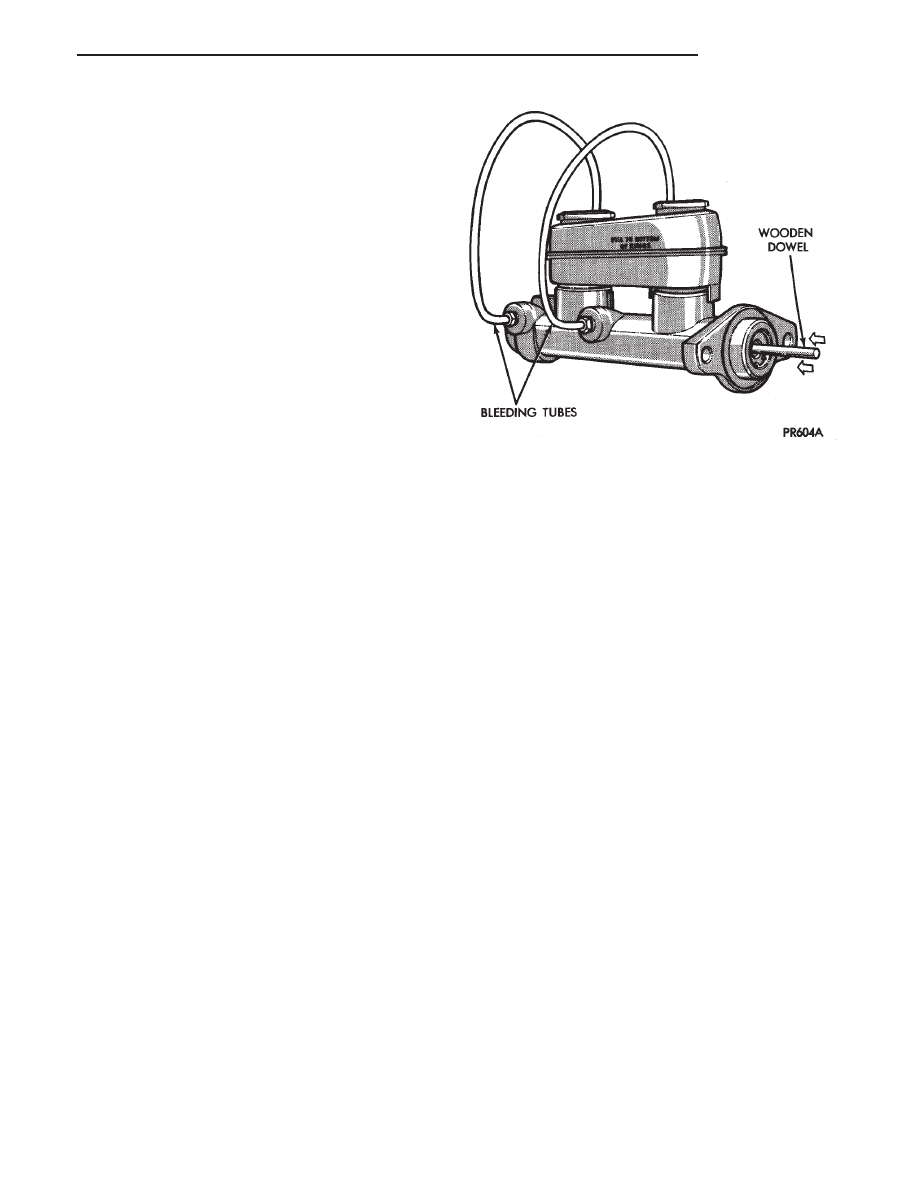Chrysler Town & Country/Voyager, Dodge Caravan, Plymouth Voyager. Manual - part 167

Slide master cylinder straight out, and away from
power brake booster unit.
BLEEDING MASTER CYLINDER
Clamp master cylinder in vise and attach Bleeding
Tubes, Special Tool C-4546 (Fig. 5).
Use a residual valve on outlet of each bleeder tube, to
keep air from being drawn back up tube and into
master cylinder.
Fill both reservoirs to the appropriate full mark, with
approved brake fluid.
Depress push rod slowly and then allow pistons to
return. Repeat several times until all air bubbles are
expelled (Fig. 5).
Remove bleeding tubes from master cylinder. Plug
outlet ports on master cylinder and install caps on fluid
reservoir.
Remove master cylinder from vise and install master
cylinder back on the power brake unit.
It is not necessary to bleed the entire hydraulic
system after replacing the master cylinder. Pro-
viding that the master cylinder had been thor-
oughly bled of all air and filled with approved
brake fluid before installing it on the vehicle.
INSTALL
Position master cylinder over studs on power brake
unit, align push rod with master cylinder piston.
Install master cylinder to power brake unit attaching
nuts (Fig. 4) and tighten to 28 N
Im (250 in. lbs.).
Connect brake tubes to master cylinder outlet ports.
Tighten the brake tube to master cylinder fittings to 17
N
Im (145 in. lbs.).
POWER BRAKES
INDEX
page
page
General Information
. . . . . . . . . . . . . . . . . . . . . . . 51
Service Procedures
. . . . . . . . . . . . . . . . . . . . . . . 52
GENERAL INFORMATION
A 270 mm power brake booster assembly is used on
these vehicles (Fig. 1 and 2).
The purpose of the power brake booster is to reduce
the amount of force applied to the brake pedal, to
obtain the required hydraulic pressure in the brake
system to stop the vehicle.
The power brake booster can be identified if required,
by the tag attached to the body of the booster assembly
(Fig. 1). This tag contains the following information.
The production part number of the power booster
assembly, the date it was built and who manufactured
it.
The power brake booster assembly is not a
repairable part and must be replaced as a com-
plete unit if it is found to be faulty in any way.
The power booster vacuum check valve is not
repairable but can be replaceable as an assembly.
The power brake booster in vacuum operated. The
vacuum is supplied from the intake manifold through
the power brake booster check valve (Fig. 1).
As the brake pedal is depressed, the power boosters
input rod moves forward. This opens and closes valves
in the power booster, creating a vacuum on one side of
a diaphragm and allowing atmospheric pressure to
enter on the other. This difference in pressure forces
the output rod of the power booster out against the
primary piston of the master cylinder. As the pistons in
the master cylinder move forward this creates the
hydraulic pressure in the brake system.
Different systems and engine combinations require
different vacuum hose routings. The hose is needed to
supply the power brake unit with a vacuum signal from
the engines intake manifold. This vacuum signal is
required for the proper operation of the power brake
unit. Below is listed the different hose routing require-
ments and routing illustrations.
Fig. 5 Bleeding Master
.
BRAKES
5 - 51